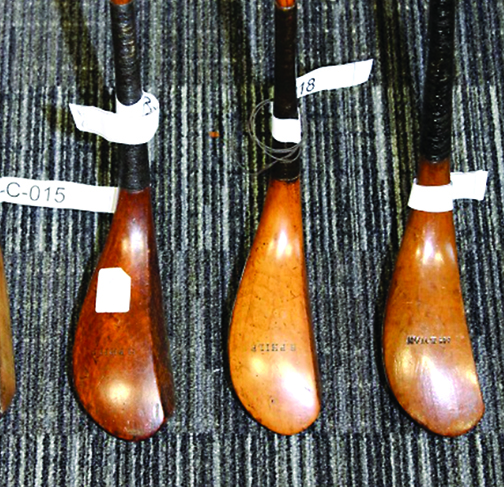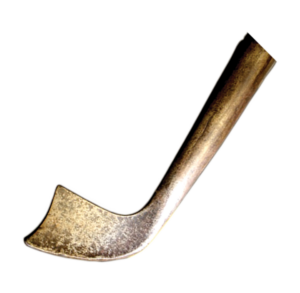
By Brian Matheson, with John Still
The Golf, March 2018
Editor’s note – Brian Matheson is a member of the British Golf Collectors Society and a friend of Dr. Billy Detlaff, whom he recently hosted on the latter’s lecture tour of Scotland centering on his book Doctors of the Game – A History of the Golf Professional. Brian recently researched and wrote about the legacy of a golfing family from Carnoustie, the “Hunters of Blackness,” and in doing so, in collaboration with colleague John Still, was able to identify clubs held in a secure bank vault for the Royal Musselburgh Golf Club as the very same clubs mentioned as gifts to the club in a letter from David Hunter in 1901. The club’s records also indicate a gift around that time of clubs from Douglas McEwan thatwere made by his famous club-making ancestors. Very rare indeed! The text below is excerpted from Matheson’s complete article, which may be found on the GCS website under “Bulletin Extras” for March 2018. It is abridged here for space.
Hunter Play Clubs and the remarkable RMGC Archive
On the 24th January 1901 the club minutes (of the Royal Musselburgh Golf Club) reported Captain Tait had submitted a letter to the club’s Council that he had received from David Hunter of Blackness. In the letter, David wrote asking Captain Tait to accept, on behalf of RoyalMusselburgh Golf Club, the clubs “I left the other day with Mr Smith, Clubmaster.”
The clubs belonged to his grandfather Alexander Gibson Hunter who had been Captain of the club in 1810. David went on to say there were a few more around the house and when he came across them he would hand them in. The Captain also stated he had secured two Philp clubs from Douglas McEwan at the price of £2 each.
These items above were “additions” to a collection of antiquities which seemed to start with a letter on November 7th 1900. DouglasMcEwan had written to the club intimating his desire to hand over to the club certain old golfing relics representing as he does the fifth generation of McEwan
Golf Club Makers in Edinburgh and Musselburgh. Douglas informed that he had some old golf clubs handed down to him from his “forefathers.” The letter, while eloquent, has considerable significance historically as it describes the gifts. The club minute records that the gift would form the “nucleus” of the club’s archive.
The Douglas McEwan letter:
“I would like to present the Royal Musselburgh Club with one or two of these in testimony of the kindness which has always been shown to me and the support our family has had from the Members. I will hand over two clubs, which I believe to be the oldest in my possession. Unfortunately, I cannot give the date exactly but I have one made in 1700 by Dickson of Leith and it is safe to say that these two are older. I will also give over an unused Driver made by my uncle William McEwan who died in the ‘fifties’ and a feather ball made by Douglas Gourlay my great grandfather’s father – in –law. I shall be glad to know that the club will accept these articles”
A discussion followed the reading of McEwan’s letter and the club’s Secretary informed that several members had intimated their willingness to make similar donations. The Council “were at one in taking the view that such a collection garnered on economical lines would be in the interests of the club.”
(Editor’s note – The Council then agreed to lend many items to the upcoming Scottish History and Archaeology Section of the Glasgow International Exhibition of 1901, as long as “satisfactory terms as to transit, protection, and safe return” could be made. All items were satisfactorily returned.)
A remarkable collection
In order to provide further depth to this article I approached the Royal Musselburgh Club requesting permission to view their archive held in a secure bank vault in Edinburgh. I also wanted to photograph the archived clubs to see if it was possible to identify David’s gift of the three clubs belonging to his grandfather. This turned out to be far harder than I expected as the number of archived clubs exceeded my expectation! The club maker’s names on the clubs were well known but not being an “expert,” after seeking the advice of John Pearson, I contacted John Still in Edinburgh. I sent John Still all the photographs of the clubs archived in
Edinburgh and arranged a further visit for both of us to ‘Royal Musselburgh’ to inspect the clubs held separate from those held in RMGC’smain archive.
Here is John’s report on his findings:
Approaching the clubhouse of The Royal Musselburgh Golf Club one is immediately struck by the impressive building in parkland of a castellated Scottish baronial house with high towers in sandstone.
Unfortunately the building inside does not continue the grandeur and there is no apparent sign that this is the 6th oldest club in existence with a history emanating from the original Bruntsfield Links in Edinburgh and then the Old Musselburgh Links similar to the origins of The Honourable Company of Edinburgh Golfers, The Royal Burgess and The Bruntsfield Links Society.
My visit, however, was to view the golf club and memorabilia archives to find out whether the original gifts by David Hunter of Blacknessof his grandfather’s golf clubs and the donation by Peter McEwan were still part of the club’s archives. I was shown first of all the clubs on display in the clubhouse and was underwhelmed to find nothing of significance.
As the main archive was held “off premises,” I was shown a catalogue of items held in safekeeping at the bank. It was soon clear that some wonderful iconic clubs were owned by the club and I was further enlightened as Brian (Matheson) had diligently photographed the clubs to enable me to continue my research.
The main clue to the origin of the club collection was the club minutes on the 24th January 1901 as mentioned above together with theDouglas McEwan letter of the 7th November 1900. This letter has considerable significance historically as it describes the gifts and that the club minute records that the gift would form the “nucleus” of the club’s archive. It’s worth repeating McEwan’s words here describing his gift:
“I will hand over two clubs, which I believe to be the oldest in my possession. Unfortunately, I cannot give the date exactly but I have one made in 1700 by Dickson of Leith and it is safe to say that these two are older. I will also give over an unused Driver made by my uncle William McEwan who died in the ‘fifties’.”
The minute recording the Council’s further discussion regarding the invitation for contributions to the Scottish History and ArchaeologySection of the Glasgow International Exhibition of 1901 and the membership’s acceptance of the Council’s request provides the basis for further identification of the exhibited artefacts.
The Glasgow International Exhibition 1901 followed the lead of the previous Glaswegian exhibition in 1888 and took place at Kelvingrove Park. It ran between 2 May and 4 November at the Palace of Fine Arts and the exhibition remained as a permanent legacy becoming the Glasgow Art Gallery. Amongst the displays was one dedicated to the History of Golf and housed the several artifacts and clubs lent by Royal Musselburgh.
The Scottish Exhibition of National History, Art and Industry was then held in Glasgow in 1911. The reference to this exhibition was the book The Palace of History, Volume 2, which is a wonderful record of all the artefacts, relics and displays at the various Galleries at Kelvinside including “Golf” amongst Sports and Pastimes.
The items lent by Royal Musselburgh comprise part of a Floor Case the contents of which “are fairly representative of the implements with which the game has been played within the last three centuries.”
The curator of the collection was the Rev. John Kerr, Minister of Dirleton, and the author of The Golf Book of East Lothian, who had included a number of the oldest and most rare clubs in this Floor Display. What is clear is that “The most interesting Relics in this case are the Head of a 17th century Iron, an Iron Club (with shaft), and a 17th century Driver and Iron, which are believed to have belonged to James VII.”
These are the clubs which most probably were the gift of David Hunter to Royal Musselburgh. The clubs which were displayed at the Glasgow Exhibition 1901 and 1911 which were part of this gift were donated just prior to the 1901 Exhibition. The Earliest Clubs which I will now describe were of great rarity and value and form an exceptional archive of Royal Musselburgh Golf Club.
The Earliest Clubs:
Modern scholarship has been able to identify clubs and their age more accurately than the apocryphal stories attached to clubs handed down through the ages, therefore one can only imagine the history attached to the following Earliest Clubs forming part of the Royal Musselburgh collection.
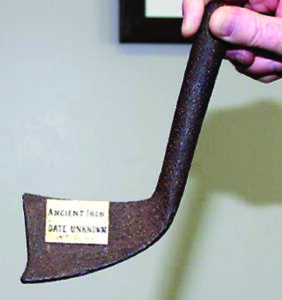
Head of a 17th Century Iron. This club, shown above, belongs to the “Spur Toe Group, with Swept Necks, as described by Robert Gowland in The Oldest Clubs. Royal Musselburgh are fortunate in owning two clubs of this early group – the somewhat rusted head together with the following complete Spur Toe Iron.
An Iron Club (with thick shaft) as described in the Palace of History is the second of the Spur Toe Group and is a heavy iron with a distinct “spur” on the toe. This spur allowed the club to be “used hammer wise” (Golf, 9 Oct, 1896). By turning the club to align the end of the head behind the ball, a ball in a rut or nestled among stones could be struck with the end of the toe. The grip is also distinctive being a single thickness of coarse “woolen selvedge.” Such clubs are referred today as having a “list” or “listing grip.” Similar wrapped listing isfound under old sheepskin grips. The other rare and unique feature of this club is the incised ring rather than nicking to the top of the hosel. See the photo at the top of this page.
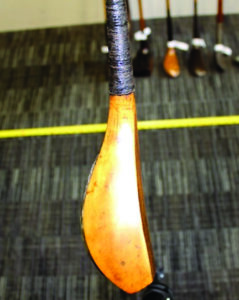
The 17th Century Driver deserves a section of its own in the The Oldest Clubs, namely “The Royal Musselburgh Club” described on page 53 of the Gowland book. It is categorized in the Splay Toe Group but is unique to this group because of the horn retained with three pegs rather than four. The pale hawthorn-headed club, shown above, has a hickory shaft with sheepskin grip although hickory was said to be imported in the 1850s, therefore it may be a replacement. It is described as being turn-of-the-1800s although I believe it to be the 17th Century Driverdescribed in the Palace of History. This club is described in Gowland’s book (Page 176) as the Driver, which is the oldest in the set of relics collected by the McEwans.
Dr. McPherson of Golf Past and Present said “McEwan of Bruntsfield once showed me a club presented by James II to Dickson of Leith, his forecaddy, MrMcEwan who gifted this club (to Royal Musselburgh) has supplied all corroborative evidence of the Royal ownership.” This is the three-pegged wood of the splay toe group, still owned by Royal Musselburgh.
The fourth club in the group of Earliest Clubs is the 17th Century Iron or Putter, known to present day collectors as the “ringmaker” because of the ornamental ring cut around the top of the 7/8-inch thick hosel, certainly one of the earliest putters known. There are only 20 extant clubs with this distinctive knurling or “ringmaker,” the name coined by Bob Gowland. (See The Oldest Clubs page 150.)
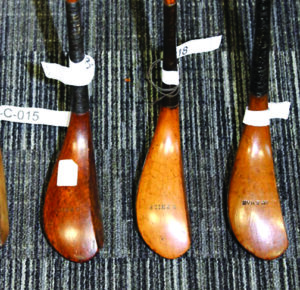
The Royal Musselburgh collection also contains two of the finest Philp clubs, which as mentioned earlier were purchased for £2 from Douglas McEwan. Philp clubs have been termed the Stradivarius of Golf Clubs and the two examples – one of light hawthorn and the other a rich honey colour – show the refined and elegant shape which are loved by aficionados of early clubs. See photo above.
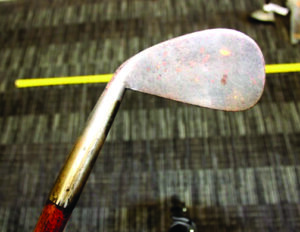
There is an example of the Oval Dish Face Group, which dates from the last quarter of the 18th century. As the large oval faced shaped head reduced gradually over the 1800s it evolved into the conventional blade shape. See the photo above.
Besides these iconic clubs, Gowland in the Earliest Clubs refers on page 177 to the Floor Case number 219 in the list of exhibits as “A case of clubs lent by Royal Musselburgh,” which included several clubs generally described in the catalogue but answering descriptions of severalclubs now in private collections:
Four McEwan clubs from 1770-1810, a Cossar (described as Ceaser) driver, and a club marked “A D”, supposedly by Dickson of Leith.
There are certainly four McEwan’s still in the collection and it is possible that the archivist the Rev. Kerr obtained clubs from other sources to include in the case as there are several clubs listed which do not appear in the Royal Musselburgh collection.
No mention for example is made of the two Park woods, the Tom Morris wood, and the Robert Forgan spoon in the collection.
In total there are 23 clubs in safekeeping in the bank vault, which is not the best environment to keep such a wonderful collection. It is a great pity that these clubs are not on display to the wider world so that they can be admired for their significance to the game of golf and attributed to the Hunters of Blackness and the McEwans who made such magnanimous gifts to the archives of Royal Musselburgh. Hopefully as a result of Brian’s initiative the collection will find another home which will do justice to this iconic collection.
Writes Matheson: John Still stated in the preceding paragraphs that “the most interesting Relics in this case are the Head of a 17th century Iron, an Iron Club (with shaft), and a 17th century Driver and Iron, which are believed to have belonged to James VII. These are the clubs which most probably were the gift of David Hunter to Royal Musselburgh.”
John’s expertise seems to answer my quest – to identify the clubs owned by Alexander Gibson Hunter of Blackness. (The same clubs gifted to the RMGC by David Hunter in 1901.)
The author wishes to thank Bob Gowland for permission to use extracts from his book The Oldest Clubs.

